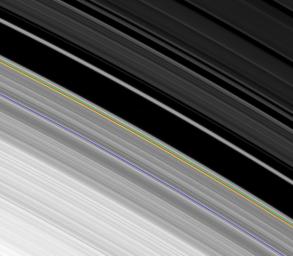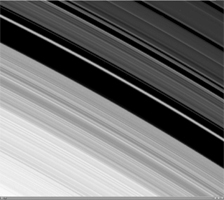
|
Oscillations at B Ring Edge
- Click the image above for a larger view
- Full-Res JPEG (1032 x 902) (85.6 kB)
- Full-Res TIFF (1032 x 902) (2.8 MB)
Caption:
|
This movie, made from images obtained by NASA's Cassini spacecraft of the outer edge of Saturn's B ring, reveals the combined effects of a tugging moon and oscillations that can naturally occur in disks like Saturn's rings and spiral galaxies.
The B ring is shown at the lower left of the frame, and its outer edge varies with time, moving in and out in this concatenation of 92 images, each taken about 6 minutes apart, over the span of 9 hours, 30 minutes. The Cassini Division, the division between the A and B rings once thought to be empty, dominates the upper right of the frame. The Huygens Ringlet runs across the middle of the frame from the upper left to lower right.
At its innermost radial distance, the B ring's edge is 117,470 kilometers (72,992 miles) from the center of Saturn. At its outermost radial distance, the B ring's edge is 117,670 kilometers (73,117 miles) from the center of Saturn. These variations amount to a difference of 200 kilometers (about 120 miles).
Cassini scientists have determined that the complicated radial variations in the B ring edge are caused by the presence of four scalloped patterns, all independently rotating around the ring. One pattern, with two lobes, is present because of the gravitational perturbations from the moon Mimas, which alter the ring particle orbits because of a repetitive configuration of particle and satellite orbital positions known as a Lindblad resonance; this pattern always stays fixed with respect to Mimas. The other patterns with one, two, and three lobes respectively, travel around the ring with differing speeds and are believed to be natural modes of oscillation of the ring in this vicinity, excited by a process known as "viscous overstability."
In this process, the small, random motions of the ring particles feed energy into a wave that propagates outward across the ring from an inner boundary, reflects off the outer edge of the B ring (which becomes distorted as a result), and then travels inward until it reflects off the inner boundary. This continuous back-and-forth reflection is necessary for these wave patterns to grow and become visible as distortions in the outer edge of the B ring.
In supporting these so-called "self-excited" modes, the outer edge of the B ring is behaving the way astronomers believe spiral galaxies behave. However, such modes are not directly observable in galaxies. Cassini's observations of the outer B ring edge constitute the first time such large-scale modes in a broad disk of material have been observed in nature.
The movie repeats twice. The second time the movie runs, the location of the Mimas resonance (marked with a green line), the locations of the inner boundaries for the one-lobed (blue), two-lobed (yellow), and three-lobed (red) modes, and the location of the mean radius of the outer edge of the B ring (white) are all indicated.
The images were re-projected into the same viewing geometry and magnified by a factor of two to increase visibility of features. Image scale was about 4 kilometers (3 miles) per pixel in the original images. These images have not been cleaned of cosmic rays that struck the camera's sensor during exposure. These cosmic ray hits appear as small white streaks on the images.
This view looks toward the southern, sunlit side of the rings from about 28 degrees below the ring plane.
The images were taken in visible light with the Cassini spacecraft narrow-angle camera on April 9, 2007. The view was obtained at a distance of approximately 746,000 kilometers (464,000 miles) from Saturn and at a sun-Saturn-spacecraft, or phase, angle of 15 degrees.
Background Info:
The Cassini-Huygens mission is a cooperative project of NASA, the European Space Agency and the Italian Space Agency. The Jet Propulsion Laboratory, a division of the California Institute of Technology in Pasadena, manages the mission for NASA's Science Mission Directorate, Washington, D.C. The Cassini orbiter and its two onboard cameras were designed, developed and assembled at JPL. The imaging operations center is based at the Space Science Institute in Boulder, Colo.
For more information about the Cassini-Huygens mission visit http://saturn.jpl.nasa.gov/ . The Cassini imaging team homepage is at http://ciclops.org .
Cataloging Keywords:
| Name | Value | Additional Values |
|---|---|---|
| Target | Saturn Rings | A Ring, B Ring, Cassini Division, Mimas, Saturn |
| System | Saturn | |
| Target Type | Ring | Gap, Planet, Satellite |
| Mission | Cassini-Huygens | |
| Instrument Host | Cassini Orbiter | Huygens Probe |
| Host Type | Orbiter | Lander, Probe |
| Instrument | Imaging Science Subsystem (ISS) | |
| Detector | Narrow Angle Camera | |
| Extra Keywords | Color, Rotation, Visual, Wave | |
| Acquisition Date | ||
| Release Date | 2010-11-01 | |
| Date in Caption | 2007-04-09 | |
| Image Credit | NASA/JPL/Space Science Institute | |
| Source | photojournal.jpl.nasa.gov/catalog/PIA12795 | |
| Identifier | PIA12795 | |


